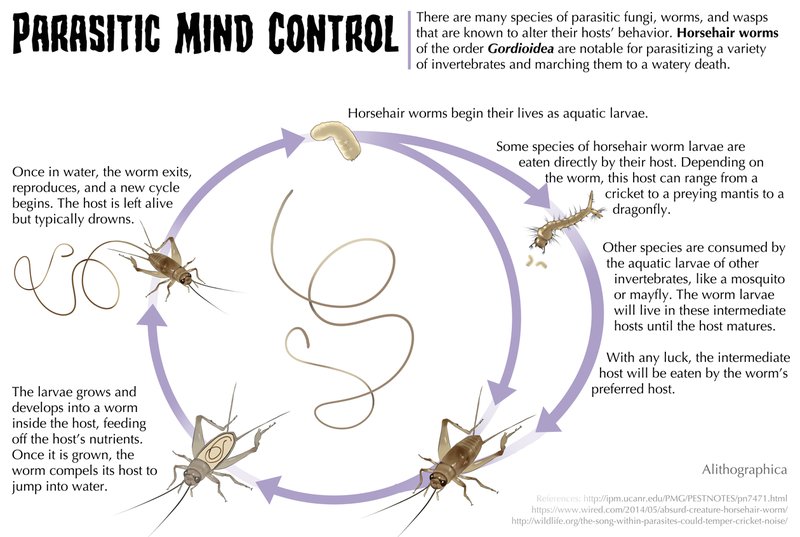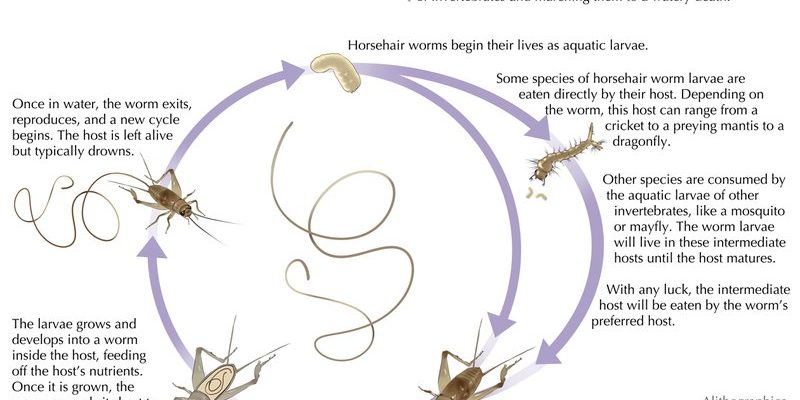
Hairworms, or *Nematomorphs*, are known for their mind-bending life stages. They start as tiny creatures living inside hosts—often insects—before emerging to live freely in water. If you’ve ever seen a cricket jumping around uncontrollably, only to find it near a body of water, there’s a good chance it’s under the influence of a hairworm. So, grab your coffee and let’s dive into the intriguing journey of the hairworm, exploring each stage of its life cycle and the behaviors that come with it.
What Are Hairworms?
Before we dive deeper into their life cycle, let’s clarify what hairworms actually are. These offbeat creatures belong to the phylum *Nematomorpha*, which means “thread form.” Hairworms are long and slender, resembling strands of hair—hence the name. They can grow anywhere from a few inches to over a foot long, depending on the species.
It’s interesting how these worms primarily dwell in aquatic environments as adults—think rivers, streams, and ponds. In contrast, they spend their juvenile phase inside the bodies of various invertebrate hosts. This unique duality is what makes their life cycle so fascinating. You might wonder how they manage to manipulate their hosts, and that’s where things get even more intriguing.
The Life Cycle of the Hairworm
Hairworms have an impressive and complex life cycle, typically divided into four main stages: egg, larva, juvenile, and adult. Let’s explore each stage in detail.
1. Eggs
The journey begins when adult hairworms lay their eggs in or near water sources. The eggs are often attached to vegetation or float freely. They look almost like tiny jellybeans, but don’t let their cute appearance fool you. Inside each egg is a developing larva, ready to take on the world.
Once the eggs hatch, the larvae emerge into the water. At this stage, they are tiny and vulnerable, but they’re also highly adaptable. The larval stage is crucial as it’s the beginning of their life cycle and ultimately shapes their future existence.
2. Larval Stage
After hatching, these little larvae have a specific goal: to find a suitable host. They’re drawn to the bodies of insects, particularly crickets and grasshoppers, which are more likely to be found nearby. Once they find their host, they burrow into the insect’s body, where they can grow and develop without the dangers of the outside world.
This stage can last several weeks to months, during which hairworms are growing and feeding on the host’s internal nutrients. You might be wondering, how do they manipulate their hosts? Well, it’s believed that the hairworm releases chemicals that affect the host’s nervous system, urging it to seek out water.
3. Juvenile Stage
At this point, the hairworm begins to transition into its final form. Inside the host, it grows longer and begins to prepare for its next significant change. This stage is particularly fascinating because the host becomes increasingly compelled to jump into water, despite its natural instincts to avoid it.
You can picture a cricket that suddenly becomes obsessed with heading toward a body of water, all the while unaware it’s being controlled by its inner parasite. It’s a bit like a puppet on strings, and this bizarre behavior is a survival mechanism for the hairworm. Once the host is in the water, it’s time for the hairworm to make its grand exit.
4. Adult Stage
As the host dives into the water, the hairworm emerges. This transformation is dramatic and quite unlike anything you might expect. The adult hairworm is now free to swim and search for a mate.
In this final stage, they can live for several months, primarily focusing on reproduction. Adult hairworms are quite productive, laying hundreds to thousands of eggs to continue the cycle. It’s a fascinating, albeit gruesome, reminder of how interconnected life can be—even in ways that seem downright creepy.
Behavioral Patterns of Hairworms
The behavioral patterns of hairworms are as captivating as their life cycle. Understanding these behaviors can give insights not only into the worms themselves but also into the intricate relationships they maintain with their hosts.
Host Manipulation
One of the most remarkable aspects of hairworms is how they manipulate their hosts. As mentioned earlier, once inside, they can control the host’s behavior, driving them toward water. This mind control is believed to be a result of chemical signals that alter the host’s nervous system.
Imagine a cricket that suddenly feels an overwhelming urge to jump into a pool, where it will meet its demise. This manipulation may appear cruel, but it’s a brilliant survival tactic for the hairworm. After all, it needs water to thrive and reproduce, and the host plays a vital role in that process.
Interactions with the Environment
Hairworms play a unique role in the ecosystem. They not only serve as parasites to their host insects but also contribute to population control within those host species. By limiting the numbers of crickets and other insects, they indirectly affect the broader food chain.
Additionally, the emergence of adult hairworms into aquatic environments can also influence local ecosystems. It adds a layer of complexity to the relationships between various species, as these adult worms become prey for fish and other aquatic animals.
Why Understanding Hairworms Matters
You might be wondering why we should pay attention to creatures like hairworms. Aside from their inherent curiosity and creepiness, understanding their life cycle and behavior can have broader implications for science and ecology.
Insights into Parasites
Studying hairworms can provide insight into the workings of parasitism. Parasites like hairworms are fascinating subjects for research because they demonstrate complex relationships typically found in nature. Understanding these dynamics can aid in studies of disease control and ecological balance.
Moreover, insights gained from studying their behavior might lead to discoveries about how parasites can affect host behavior more broadly, which is crucial in fields like psychology and neurobiology.
Impact on Biodiversity
As we learn more about hairworms and their place in the ecosystem, we can better appreciate the delicate balance of biodiversity. Every creature, no matter how strange, plays a role in the larger web of life. Hairworms remind us that even the oddest life forms have their place in nature’s grand design.
The life cycle of the hairworm is a captivating journey from egg to adult, filled with peculiar behaviors and intricate relationships. These fascinating creatures remind us of nature’s complexity and the often-overlooked connections between species.
Whether you’re studying them for academic purposes or simply intrigued by the wonders of nature, understanding hairworms provides valuable insights into the intricate web of life on our planet. So, the next time you see a cricket or a stream, consider the extraordinary story of the hairworm that may be at play, subtly shaping the world around us.

